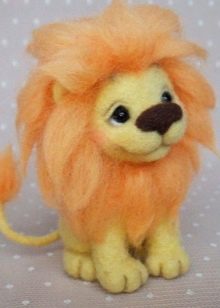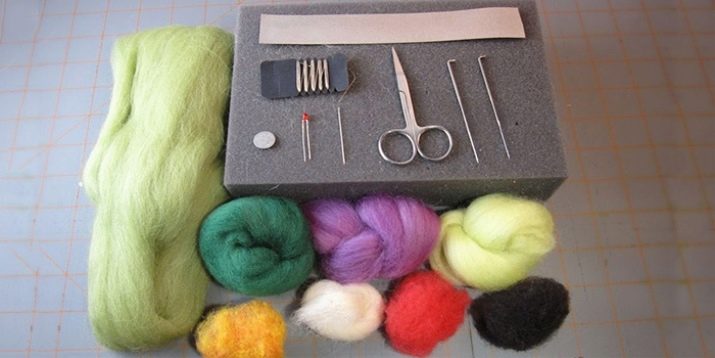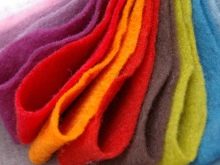Felting tools and materials

Just look at this beauty! No, these are not living beings! These are felt products. It's hard to imagine, but you can make such realistic toys with your own hands using the dry felting technique, which is also called felting or felting. In addition to dry felting, there is a wet felting technique.



But before starting work, you need to familiarize yourself with the necessary materials and tools. We will talk in more detail about each technique and materials in this article.
How the technique appeared
The history of the origin of felting goes back far into the past centuries. This technique began to emerge among the nomads. Basically, camel wool was used to make clothes, shoes, carpets, and yurts. Such things are durable, they are not afraid of any weather conditions. It is cool in summer and warm in winter.
It is not for nothing that today wool products remain relevant among nomadic peoples. For example, in Mongolia yurts are used, because they are easy enough to carry.

The felting technique was also popular among the Russian people. Wool was used to make clothes, insoles, hats and, of course, felt boots (it is known that their name comes from this technique). Steam was used to dress these shoes.
Closer to our time, in the 19th-20th centuries, felting began to develop on an industrial scale.

Only pet hair is suitable for felting, since its fibers have the ability to firmly adhere to each other.
Views
As mentioned earlier, there are two main felting techniques: dry and wet. Despite the fact that both techniques are called felting, there is little in common between them, the set of necessary tools is strikingly different. We'll take a closer look at each technique separately.
Dry felting
This technique is easier than wet.But even this type of felting requires knowledge and skill. And, of course, many materials are required, they can be ordered on the Internet or bought at almost any handicraft store. To make it easier for a beginner, there are commercially available special sets for felting wool, we'll look at them later.

Instruments
Let's take a look at the basic tools that will be needed to create a toy.
- Needles. This is the main tool. Felting needles are definitely different from sewing needles. They have special notches so that the wool catches with each other. Felting needles differ in shape (triangular, star-shaped, conical, tristar, diamond-shaped, cylindrical) and in numbers (the main ones are No. 36, 38 and 40, the higher the number, the thinner the needle). For convenience, needles with markings are used, as well as special holders.
- An equally important tool for felting is the spongy base, on which, in fact, the work is done. It serves to protect fingers from punctures, as this element can serve as a regular dishwashing sponge, and a special base. A brush can also be used for this purpose.
- There are also various felting accessories, for example, thimbles are especially useful for beginners. There is also a comb for wool to fluff the product or separate the felt from the total mass.



Wool
The most important material in felting is, of course, wool. There are many types of felt. Let's analyze the main ones:
- cardo - wool for felting, which is great for beginners, as it felts well;
- merino - expensive and high-quality wool, which is used to apply the top layer to the product;
- corridale - thick and easy-to-use felt;
- cashmere - a very famous type of wool, used mainly for decoration;
- perfect for the base wool sliver.



Beads, beads, lace, ribbons and special noses and eyes are used as decor to make the toy look more realistic.
Wet felting
There is little in common between this technique and the previous one, only the material in common, that is, wool. But this type of felting also deserves attention.
The main types of felts used for wet felting are Blueface Leicester, Wensleydale and camel wool.


It is important to know that it is necessary to correctly select the colors of the coat, so that when exposed to water or soapy water, it does not spoil the depth of tone, and also so that different colors do not mix with each other.
This technique is notable for the fact that it uses mostly improvised items. Here are the main ones.
- If in dry felting the main tool is needles, then in the wet method it is water. It is with the help of water that the wool subsequently falls off and takes shape. In order to evenly distribute the liquid, you will need a spray bottle (spray gun); a watering can with a fine nozzle or an empty perfume bottle is also suitable for this purpose.
- Just as in dry felting, a base is required - this technique must have a corrugated base so that the wool does not slip, any rubber mat (simple or specialized) will work for this, and you can also use a bubble wrap for packaging.
- You will also need soap to soften the water and protect your hands.
- In order to prevent the wool from tangling during felting, a mesh or any thin fabric is needed.
- To make it easier to work with your hands, you will need a rolling pin (thanks to the rolling pin, you can apply a lot of force to the dump).
- You will need a towel or paper towel to remove excess water.
- If you want to protect your hands, then arm yourself with cellophane or rubber gloves.
- Sometimes experienced fellers use a washing machine for work; in this case, various forms for felting are additionally used. Often, instead of specialized forms, improvised items are used, for example, nylon tights.

Molds for felting are used without the participation of a washing machine; You can also use bakeware to save money.
It is impossible not to mention a wonderful device - a felting machine... Thanks to her, work goes much faster. For dry felting, sandpaper is used as a nozzle, and for wet felting, cellophane packaging film. There are also machines in which, instead of a nozzle, there are many needles for felting (for faster dry felting by hand, like a device, you can use several needles at once).

Creator's Kit
Now consider the kits for felting wool, which are available in handicraft stores or online stores.
Kits for making toys according to the scheme are often sold, which include: instructions for felting this craft, several types of wool of different colors, 3 needles of different sizes (it is better to purchase several more needles separately, since they tend to break), a spongy base. On sale, you can often see creative sets for children.


Probably more popular wet felting kit, according to this technique, flat parts are made, which are then sewn together, or already a whole product. But there are also kits for creating paintings from felt. Let's tell you more about them.


The kit for creating a picture from wool includes: natural wool of the required colors, a base for the picture, tweezers, a stencil and instructions with diagrams and step-by-step descriptions of the work. To create a craft, you will need additional items that were mentioned earlier, for example, a soap solution and a spray bottle.
Such sets are suitable for children's creativity (of course, strictly under the supervision of adults) and for adults. They are most often purchased by beginners to make their work easier.
For an overview of materials and tools for beginners, see the next video.








